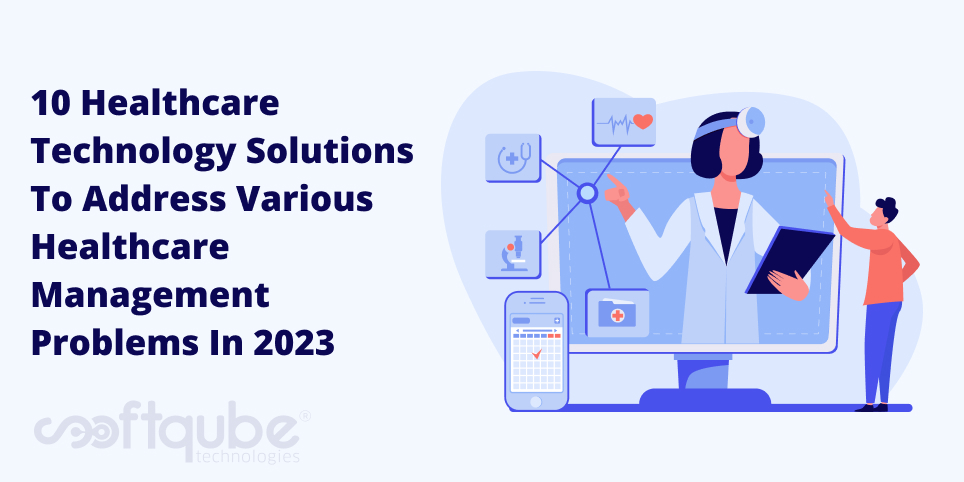10 Healthcare Technology Solutions to Address Various Healthcare Management Problems in 2023
December 27, 2022

Table of Contents
- Introduction
- The solution to healthcare problems with technology
- Problem 1: Unavailability of remote access
- Problem 2: Errors and inefficiencies in Data Sharing
- Problem 3: Siloes in the Healthcare industry
- Problem 4: Issues with Medicaid and Medicare
- Problem 5: Absence of the Supply Management System
- Problem 6: Managing the huge volume of the data of patients
- Problem 7: Scarcity of Online Pharmaceutical Stores
- Problem 8: Slow pace with the modern solutions
- Problem 9: Absence of early morning healthcare devices
- Problem 10: Shortage of mHealth applications
- Future of Technology
Introduction
You must have heard about ‘Smart ambulance’ and it functions exactly as it sounds. In recent times there has been quite a buzz in the market revolving around 5G technology. Fortunately, the healthcare sector is among its vital use cases. Smart ambulances sound really fascinating, and it means you will be able to connect with various entities – oxygen cylinders, ventilators, ECG machines, everything- to begin the diagnosis exactly at the time when the patient is wheeled inside an ambulance. All vital parameters are sent back to the hospital- the centralized command. For humans, undoubtedly, it is going to do great wonders.
The transformation in the healthcare sector is shifting from a catchword to an imperative for the health systems.
Over the last two decades, health systems and hospitals have unveiled digital technologies in their functional zones. The Covid pandemic altered the status quo of the healthcare industry significantly, with home care and virtual health becoming the model. It has not only become a necessity for many but is preferred by many too. The pandemic accelerated various trends, including shifts in consumer preferences, clinical innovation, newer talent models, and rapidly evolving technologies. Faced with these trends, with health systems and hospitals working to adapt their businesses, a pretty well-defined approach to digital technologies will probably be the core of this transformation strategy. Now let’s dive into the solutions to solve various healthcare management problems.
The solution to healthcare problems with technology
Technology helps you to stay ahead of the curve as well as lends a hand to place you among the best technological healthcare providers. Some most addressed problems that the innovative advanced healthcare system is able to solve with the use of technology for a healthier and better world have been discussed.
Problem 2: Errors and inefficiencies in Data Sharing
In an era where medical science has made significant healthcare errors, inefficiencies and advancements are still persistent. This is because of the traditional technology for the management of the healthcare industry. This is not only an obstacle in medical science, but it causes regression due to the waste it generates. The patients pay the price in the form of health and inconvenience, and also, there is a rise in litigation and administrative expenses owing to these errors and efficiencies.
A particular area of concern is the exchange of patient data in the case of a patient transfer from one hospital or department to another. When patient record sharing is done in the traditional way, it is inefficient and time-consuming and exposes the information of the patient to a security breach. An inefficient and incomplete exchange of data can be dangerous for patients who need complicated or urgent treatment.
Solution: Blockchain-based Database
To deliver a satisfactory and holistic patient experience, various parties who are involved in healthcare, such as doctors, patients, insurance providers, and scheme providers, must be able to exchange information securely among themselves. Using the systems of cloud-based data management can be a stable solution to solve the inefficiencies that are caused by the outdated pen-and-paper style of managing the data. The latest up-and-coming solution to the healthcare management issue is to use a blockchain database to store as well as share patient records. The healthcare technology trend is able to eliminate insecurity, thereby maintaining the integrity and privacy of patient information.
Problem 3: Siloes in the Healthcare industry

Healthcare professionals are disconnected as well as working in silos. Any missing platform may bring the healthcare world into one single page where they are able to discuss their learnings, create notes, and share knowledge. If there exists one single platform exclusively for the healthcare sector, then things would have become much better. Everyone could learn from anyone, thereby leading to better understanding, leading to better diagnosis, and treatment.
Solution: Development of a Networking app for the healthcare professionals
Developing a social networking app exclusively for healthcare professionals is able to solve this problem. Something like The On Call Room (OCR)- the mobile platform for healthcare professionals. The app covers various things, including the recent development in the healthcare world; the ability to share videos, excel sheets, PPTs, PDFs, and photos; the ability to comment and like, post new statutes, and ask questions, also the ability to share the data of patients among the healthcare professionals. This is a pretty viable solution helping to create a better and healthier world by enabling communication and collaboration in the health sector. Sharing problems may solve health issues while promoting inclusivity.
Problem 4: Issues with Medicaid and Medicare
Medicaid and Medicare are the health programs of the government providing healthcare coverage to patients. The repayment structures of these programs significantly vary and need to maintain a process of orchestrated management. The processes for receiving and filling Medicaid and Medicare are pretty different and are an additional task on the healthcare professionals’ to-do-list. Also, for the services rendered, the regulations need them to record and store patient records in one particular format. The doctors have to fill out some prescribed electronic forms during the times when treatment is availed under Medicare. This proves that the patient is given the healthcare service. The rules and regulations are made mandatory for the healthcare pros to follow these processes to get paid. This adds to their problems.
Solution: Investing in Medicaid and Medicare EHR System
A disruptive political issue is healthcare reform. EHR (Electronic Health Record) is among those healthcare trends which the industry is prepared to embrace to simplify the health record-keeping and Medicaid and Medicare filling. The EHRs offer an apolitical tool for controlling the expenditure of healthcare. This was expected to grow at a rate of 5.8% until this year.

The EHR system enables the proper electronic forms for Medicare and Medicaid reimbursement from the government. For healthcare professionals, it is easy to keep the health records of the patients and fill out the forms for reimbursements when the service has been offered. Organizations realize the value of keeping a sound HER system. For a better understanding, have a look below.

Also, these systems help improve the transaction of data and information from doctors to the government and from the government to doctors. Also, they standardize the format of data as required by the government for disbursing claims instead of speeding up the submission of the patient files as well as requesting payments for the services that have been rendered. Moreover, tracking the medical history of a patient online eases the nuisance of maintaining paper files. In this way, the doctors are able to focus more on their key functionalities and provide effective coordinated care with the other doctors to plan personalized, cohesive treatment plans.
Problem 5: Absence of the Supply Management System
Healthcare services form the backbone of the industry. The efficient practices certify smooth healthcare services. Nevertheless, managing these logistics is still a tricky task. Whereas it might sound like a problem of supply chain mismanagement, it creates issues such as drug or equipment shortages at the backend and mismanaged medical inventory. At the doctor’s end or the front end, it causes inefficiencies, and at the end, for patients, it results in danger to their health. Often traditional supply chain management is efficient and wasteful. It leads to the wastage of money on damaged and lost inventory, inappropriate delivery of medication or equipment, and the damage caused to the patients, everything resulting in massive financial losses for the healthcare services. Less-than-stellar preventive measures about shrinkage, misplaced inventory, and supply shortages, everything plays into the reality that without a definite supply chain system, the hospitals are the epicenters of these wasteful operations.
Solution: Investing in the Data Management Systems
To avoid unnecessary spending or heavy losses, it is very important to turn digital healthcare technology providers into effective and powerful solutions. A strong data management system driven by data analytics is updated constantly and operates within one easy-to-use GUI (Graphics User Interface), and provides meaningful and insightful data. In this manner, medical and administrative professionals are able to access the current budget allocations and accurate inventory numbers.
Problem 6: Managing the huge volume of the data of patients

The patient-related data is among the most overwhelming aspects of the healthcare industry. With every new addition to the database of patients, the already existing pool becomes bigger. Therefore, it becomes tough to manage the data. The traditional infrastructure of securing and managing data is unrealistic. The retrieval and storage of this patient data, whenever required is quite a challenge that the hospitals need to address immediately. Data mismanagement and overload often lead to the wrong diagnosis, lapsed appointments, improper treatment, compromise in the security of data, regression of the condition of the patients, failure to keep up with the alterations in progress, etc. These implications can be catastrophic for both patients and doctors.
Solution: Data Analytics + Cloud Capabilities
The solution of healthcare technology to this issue lies in mobile portals and cloud-based data systems. These solutions provide healthcare professionals access to real-time data such as appointments, treatments, diagnoses, medical history, registrations, and more. As the retrieval and storage are cloud-based, these records are appropriately secured and are updated in real-time. The cloud-based solutions which help in maintaining a database of a patient are also data analytics capabilities and handy options. The healthcare mobile app integration and development of these apps, dependent on Android, iOS, and other mobile platforms, offer more flexibility for practitioners and doctors throughout their workday on the go.
Problem 7: Scarcity of Online Pharmaceutical Stores
An increase in the number of pharmaceutical stores all over the wave has changed people’s shopping habits, and they want everything and anything available online. The scarcity of online medical stores creates a problem making the industry lag in comparison to the other sectors. As the medicines that are sold online must be prescription based, a scarcity of e-stores may disrupt the market and will bring convenience to the customers.
Solution: Setting up online medical stores based on prescription
To launch an online pharmaceutical store must be on your list. The online market has huge potential. The online medical stores offer home delivery for prescription-based medicine. All you require to get started is an eCommerce platform such as BigCommerce, Shopify, Magento, etc.; developers who will design and create a mobile app and a website; and a delivery management system to streamline the last-mile deliveries.
Problem 8: Slow pace with the modern solutions
In this vast world, our knowledge is very limited so we have to learn more about the mechanisms underlying several diseases that are caused by viral infections. Any slight change in human DNA could prevent various ailments.
Solution: GET (Genome Editing Technology)
With the discovery of gene-editing technology, recent technology has resulted in real innovation in genetic engineering. It helps in treating hypertrophic cardiomyopathy, muscular dystrophy, and cystic fibrosis. This is a field of study that modifies the gene of living organisms to improve our insights into the gene function as well as develop methods for treating acquired or genetic diseases.
Problem 9: Absence of early morning healthcare devices
Events like strokes and aneurysms and diseases like cancer frequently catch doctors off guard. Often it is very late to do much, and various patients die not due to the fact that they cannot be saved but due to the fact that it is really late to save them. We require more devices that can monitor patients remotely with long-term or chronic situations, track their medical orders, and also their location where they get admitted to the hospitals, as well as wearable mHealth devices that are able to send information to the caregivers. The medical devices that are converted to IoMT technology involve infusion pumps that are connected to hospital beds and analytics dashboards outfitted with sensors that measure the vital signs of the patients. Lifestyle diseases are rising, and innovative smoking is sitting. Lifestyle diseases include cancer, kidney disease, obesity, and diabetes. IoT is able to manage the risk of suffering.
Solution: Introduction of IoMT (Internet of Medical Things)
The IoMT is a collection of medical applications and devices communicating with healthcare information technology systems through online computer networks. The medical devices that are enabled with Wi-Fi help in communication via machine-to-machine, which is the foundation of this IoMT. The IoMT devices communicate with the cloud platforms like Amazon Web Services, where the captured data is analyzed and stored.
The Medtech (Medical Technology) industry manufactures and designs various products, including MRI scanners, artificial joints, surgical instruments, and pregnancy test kits. The IoMT (Internet of Medical Things)- a connected infrastructure of health systems and services is created as technology enables these devices to transmit, analyze, collect, and generate data.
IoMT, as well as its relationship with Medtech, are beneficial to help healthcare organizations to achieve better patient outcomes, implement new methods of empowering and engaging patients, improve efficiency, and lower rising healthcare costs. If Medtech is able to harness IoMT, the scale and pace of healthcare transformation will become exponential.
Wake and sleep patterns, nutrition markers, blood pressure, and other factors can be used to develop a quick and early detection for particular health conditions. When any risk is identified, a notification will be sent to the patients as well as the physicians of the patients requesting an additional test.

Problem 10: Shortage of mHealth applications
There is no direct access to the health of the patients. The available offline health systems are not sustainable, and many of us cannot afford primary healthcare, and for routine checkups depend on the ER. Healthcare professionals lack the devices and time to provide direct care to each patient. Healthcare professionals must pay attention to this. Provided that the U.S. has some expensive healthcare services worldwide, various apps are being developed for calculating the treatment costs. If you are not insured, it is the same thing as being denied access to healthcare services. Healthcare service networks, pharmaceutical corporations, and insurance companies will all benefit from the system. At the bottom of the pyramid exists the patients, but they are the foundation of the entire sector.
Solution: Launching mHealth applications to help users
People require constant access to healthcare services. Therefore mhealth apps have become quite popular, and transparency is pretty critical. The mHealth applications commoditize healthcare services to a point where all having a credit card can pay for the much-needed consultation instantly. The distance barrier is quite low, and outside their state, they can see doctors. With the age of the population, the demand for healthcare systems also rises. Due to the upcoming physician shortage, technologies like mHealth will aid in mitigating the impact. Some mobile apps that provide medical applications or medical assistance that store medical data include exercising and working out, tracking activity, pill and nutrition reminders, nutrition, personal medical data sharing, recording, and storing apps for therapists, applications in clinical presence, chronic disease management apps, and applications allowing patients to communicate with clinics or medical centers.
Future of Technology

With technology continuing to be prominent in the healthcare industry, it cannot be denied that this industry has come a long way. Healthcare technology advances in the perfect direction, from dealing with data overload across different institutions to connecting patients and doctors from opposite ends of the world via mobile applications. Digital transformation in the healthcare sector is expected to become more prominent in the upcoming times. For doctors and patients, this will bring a whole lot of opportunities. Let us bind healthcare and technology together!








